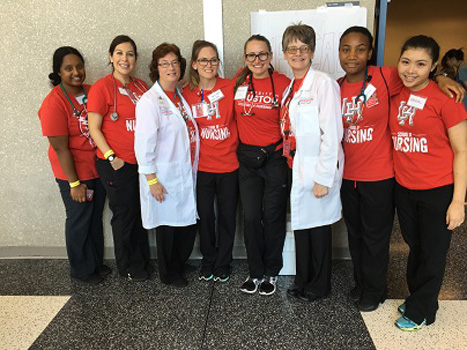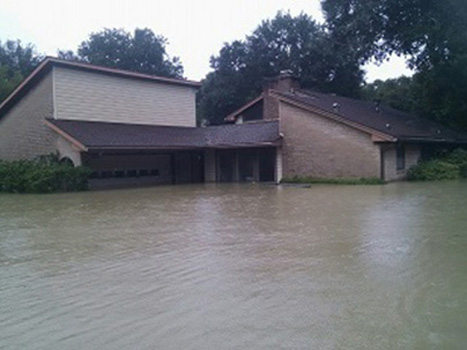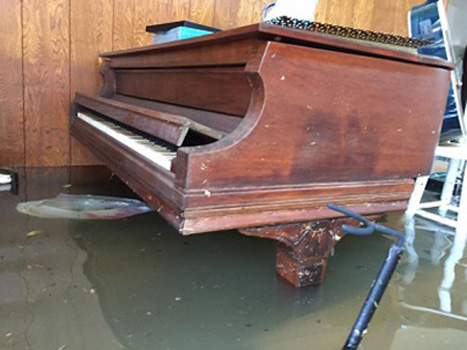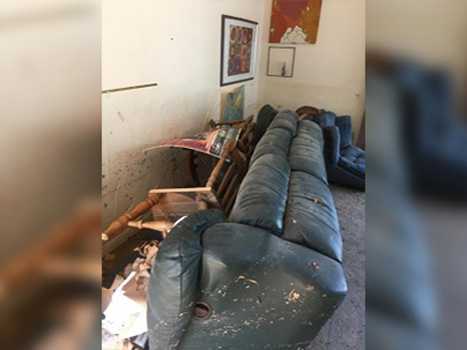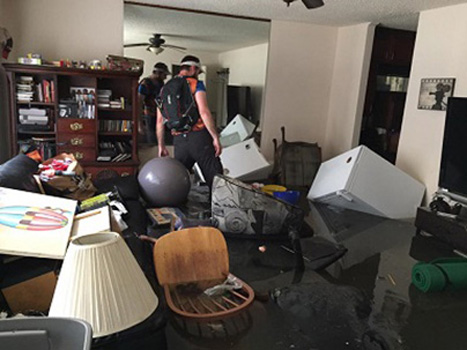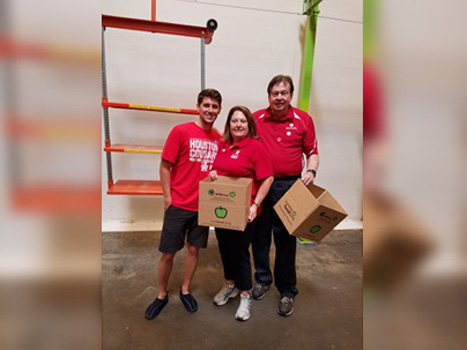A Year After The Storm
August 23, 2018
One year ago, our lives were different. On August 25, 2017 Hurricane Harvey slammed into Houston after ravaging the city of Rockport. Days before, we had been celebrating the first days of classes and marveling at a solar eclipse. The days that followed were surreal. The rain. The water. The devastation.
Below is the story we wrote last year as the University re-opened and our lives started to dry out. We cleaned up and reached out.
Houston Strong.
Cougar Strong.
September 2017
Before the first day of classes, after the storm that dumped unprecedented amounts of rain in the Houston area, students at the University of Houston College of Nursing gathered in the large multipurpose room in groups. Each table was comprised of students and one professor. This wasn’t a class. This was a time to talk about their experiences—as a volunteer, as an observer, as a flood victim.
“We know as nurses that before you can care for someone else, you have to care for yourself. We needed to talk about this traumatic event and get it out. We needed to talk and hug and cry and hold each other,” said Kathryn Tart, founding dean of the college. “And then we needed to get to work. What were the needs and who could we turn to for help.”
Tart said students talked about watching the waters rise in their homes, about losing their books, stethoscopes, uniforms and cars. They talked about needing to reach parents with medical needs, but not able to maneuver through the waters. They told of relatives lost to the currents. There were stories of pulling up carpet or sheetrock, housing displaced friends or being displaced and housed by friends.
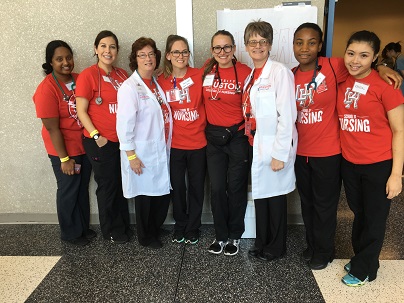
Some faculty and students who were participating in clinical activities in area hospital emergency rooms found themselves in lockdown situations, unable to leave, but able to tend to patients, their families or each other.
“As a group, we volunteered with The Fort Bend Public Health Department, the Stafford Red Cross Center, the George R. Brown Convention Center and at NRG,” Tart said. More than 60 students—futures nurses—gave hundreds of volunteer hours. “This is our profession and this is what we do.”
***
“My friend lived in Bear Creek, near the Addicks reservoir. The water was above the doorknobs in his house,” said Elizabeth Garcia, a digital media student at UH Sugar Land. Her friend also is a UH student. “He lost everything. I wanted to help him clear out the house, take pictures and document everything for his insurance people.”
Garcia captions the experience:
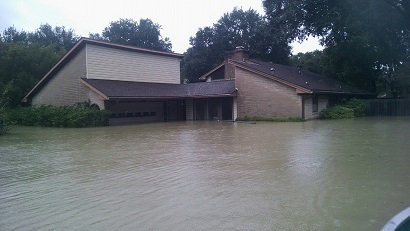
The damage is nearly total. Luke has been able to save some clothes, dishes, and glassware, but not any of his furniture, books, art, guitars, or his piano.
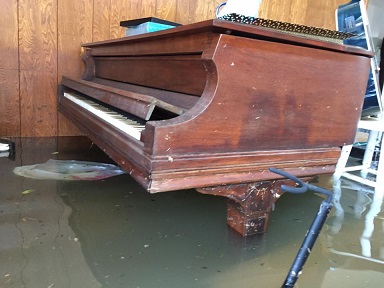
Today Luke has been documenting the damage and then taking what is not salvageable to the curb. Tomorrow is demo. I hunted down boxes, brought drinks, shuttled people to a workable bathroom, packed what I could of the dishes and delivered those to a new location to be cleaned.
Tomorrow we will move out all unsalvageable big items and Sunday is tearing out sheetrock, carpet, and wood paneling on the walls.
I wanted to do this because Luke is my friend and he needed help. My house was high and dry with no damage or loss of power. I was updated through the storm about Luke's house.
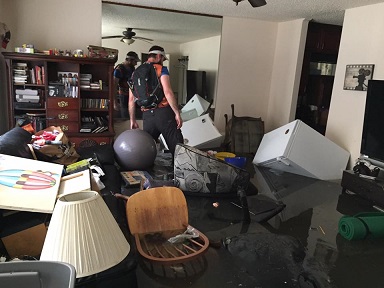
He had to evacuate on Sunday and had almost no time to get anything out. Luke is one of those students where you don't know how they do it all. He holds down a full time job and goes to school. He is incredibly smart, hardworking, and generous. We have spent many nights with friends playing games, eating good food, sharing music and laughter in Luke's home. Now it's all destroyed.
***
Faculty and students with the College of Technology Supply Chain and Logistics Technology volunteered with the Houston Food Bank in the days following the floods
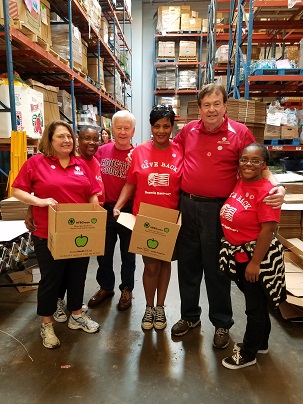
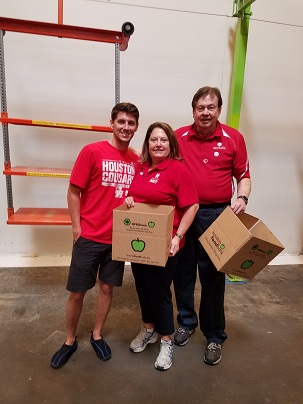
***
Emily Hardy is a nursing student in the college’s Second Degree BSN program who chose to volunteer with Baker Ripley School at the NRG Center Emergency Disaster Shelter following the devastation of Hurricane Harvey. As a student nurse, she provided assistance in patient intake and in triage of the displaced evacuees. Her training from the college ensured these Houstonians, so impacted by the storm, were identified as needing urgent care, prescription refills, needing to be quarantined—or something even more basic:
“Many of the evacuees experienced significant physiological distress because of Hurricane Harvey. Housing, food, medication and financial insecurity were commonly voiced concerns. Additionally, I provided emotional and psychological support to shelter residents.”
Emily also collaborated with shelter officials to give the evacuees in her care resources—like how to connect with the Red Cross, FEMA, CVS Pharmacy or the Texas Diaper Bank.
***
Similarly, Christopher Corredor from the same Second Degree BSN program, chose to volunteer in the days following the storm with an entity charged with setting up shelters. These teams from the Disaster Medical Assistance Team (DMAT) are comprised of similarly minded volunteers from across the country. Christopher saw evacuees with various health care needs. One such patient was in need of breathing treatments that required an electrical device. Christopher’s role was to ensure the device was charged
and to monitor the patient to make sure he was tolerating the additional stresses as well as could be expected. Student nurses are ready to assist in these kinds of situations. But sometimes the urgent need requires something softer.
“One patient was feeling stressed, understandably, due to everything that was happening and was sick on top of it all. For her, my goal was to assist her by being someone who could be there for her during her time of need and aid her during this tense time,” he said.
The teamwork he learned and displayed benefited both the evacuees and those fellow volunteers who also needed attention.
“This experience opened my eyes to a completely different side of nursing and how important it is to the community. I learned about how to provide a diverse type of care to patients during times of their greatest need and how important a shelter is to a community.”
***
David Martin is a junior majoring in digital media. He watched as the flood waters rose near his Woodland Park apartment.
“The water got over the curb. I was on the balcony watching the rain and there was a guy who flooded out and was pushing his car, so I went out to help him,” Martin said. “I saw more flooded out cars, so I blocked the street with orange cones. Later I took some video of cars coming towards the water and posted it on Twitter.”
Within moments, the online weather site “WeatherNation” asked if they could repost the video (Aug. 26 post).
#FlashFlood emergency continues for #Houston. Please use extreme care if you *must* travel the area tonight #Harvey
“I posted on Twitter as part of a class project to do seven tweets in a week. The point was to find relevant content. When you have tweets that are community related or that engage audiences then it’s relevant,” he said. “We were not asked to do this during the storm, but what better time.”
